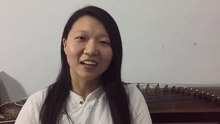Luoyang dialect
| Luoyang dialect | |
|---|---|
| 洛陽話 | |
| Native to | China |
| Region | Luoyang, Henan |
Sino-Tibetan
| |
| Language codes | |
| ISO 639-3 | – |
| Glottolog | None |
A speaker of the Luoyang dialect, recorded in China.
The Luoyang dialect is a dialect of Zhongyuan Mandarin spoken in Luoyang and nearby parts of Henan province.[1]
The serves as the historical standard of Chinese from the Warring States period into the Ming Dynasty, which distinguish from the modern Luoyang dialect.[2] It is because Luoyang switched from Southern to over history. According to Lü Shuxiang (1985), "In Northern Song dynasty, the dialects at the Central Plains are still in the southern variety [of Mandarin]; the predecessor of modern began as a tiny regional dialect near Khanbaliq".[3][note 1]
Phonology[]
This section does not cite any sources. (November 2014) |
Initials[]
| Labial | Alveolar | Retroflex | Alveolo- palatal |
Velar | |
|---|---|---|---|---|---|
| Nasal | m | n | |||
| Plosive | p pʰ | t tʰ | k kʰ | ||
| Affricate | ts tsʰ | tʂ tʂʰ | tɕ tɕʰ | ||
| Fricative | f v | s | ʂ ʐ | ɕ | x ɣ |
| Lateral | l |
| w | Labio-velar approximant |
| ɥ | Labio-palatal approximant |
| j | Palatal approximant |
Finals[]
Features[]
- The Middle Chinese entering tone has a different distribution in the Luoyang dialect than in Standard Mandarin. (See entering tone for more.)
- Tone contours are different from those in Standard Mandarin.
- The retroflex and alveolar fricatives are found in different distributions: retroflex fricatives in Standard are often fronted to alveolar fricatives in Luoyang.
- The distinction between /w/ and /v/, lost in Standard, is maintained in Luoyang.
- The retroflex series is less retroflexed than in Standard Mandarin and slightly further forward.
- The alveolo-palatal series is slightly further back than in Standard Mandarin.
- Standard final /œ/ and /ɑu/ are often backed to [ɔ] in Luoyang. For example, 学 (Standard [ɕɥœ̌]/[ɕɥě], to learn) is [ɕɥɔ], and 角 (Standard [tɕjɑù]/[tɕjàu], horn) is [tɕɥɔ].
- Standard final /əi/ is pronounced [ɯ] or [i] in certain environments in Luoyang.
- Standard final /n/ nasalizes the preceding vowel in the Luoyang Dialect.
- The -儿 suffix is pronounced /ɯ/.
Notes[]
Footnote[]
Citations[]
- ^ Kurparska 2010, p. 165.
- ^ Pulleyblank 1983, pp. 2–3; Kaske 2008, p. 44; Dong 2014, p. 45.
- ^ Lu, Shuxiang 吕叔湘; Jiang, Lansheng 江蓝生 (1985). Jìndài Hànyǔ zhǐshì dàicí 近代汉语指示代词 [Demonstrative Pronoun in Modern Chinese] (in Chinese). Shànghǎi: Xuelin chubanshe.
北宋的时候,中原的方言还是属于南方系;现在的北系官话的前身只是燕京一带的一个小区域的方言
- ^ Norman, Jerry (1997). "Some Thoughts on the Early Development of Mandarin". In ; Endō, Mitsuaki 遠藤 光暁 (eds.). Hashimoto Mantarō kinen Chūgoku gogaku ronshū 橋本萬太郎紀念中国語学論集. Tōkyō: Uchiyama Shoten. An online paywall version is available in Chinese translation, Norman, Jerry (2004). Translated by . "關於官話方言早期發展的一些想法". 《方言》 (4).
References[]
- Kurparska, Maria (2010) [1977], Chinese Language(s) : A Look Through the Prism of The Great Dictionary of Modern Chinese Dialects, Berlin; New York: Walter de Gruyter, ISBN 9783110219142, OCLC 733240264, retrieved 17 November 2014
- Pulleyblank, Edwin G. (1983), Middle Chinese : A Study in Historical Phonology, Vancouver: The University of British Columbia Press, ISBN 9780774801928, OCLC 11266119, retrieved 17 November 2014
- Kaske, Elisabeth (2008), The Politics of Language in Chinese Education : 1895—1919, Leiden; Danvers: Koninklijke Brill, ISBN 9789047423331, OCLC 317454513, retrieved 17 November 2014
- Dong, Hongyuan (2014), A History of the Chinese Language, Abingdon; New York: Routledge, ISBN 9781317743903, OCLC 877772203, retrieved 17 November 2014
Categories:
- Mandarin Chinese

